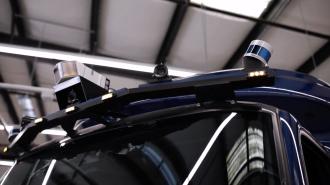If you were driving on the highway past the semi-truck operated by Beverly Morrison, you probably wouldn’t notice anything unusual. Inside the cabin, however, a game-changing experiment in freighting is playing out.
Morrison is a pilot of one of the trucking industry’s first self-driving semi-trucks. Recently, she’s been driving the same 57-mile loop in the Bay Area as part of an effort to help perfect an autonomous driving system developed by Embark, a company that outfits conventional trucks with self-driving technology.
Watch the full video on Embark:
The loop Morrison takes each day wasn’t chosen at random. “This route gives us a little bit of everything,” she said, referring to how Embark selected it because it presents the autonomous system with complex situations that self-driving trucks have to navigate, such as making a tight turn or merging onto the highway.
As the truck autonomously completes the route, Morrison keeps her hands on the wheel, ready to take manual control of the truck in the rare event that something goes wrong. She also pays close attention to how the truck autonomously navigates certain scenarios. A key part of her job as a so-called safety driver is to flag subtle areas for improvement in Embark’s autonomous driving system — the kinds of observations that only someone like Morrison, a professional truck driver with decades of experience, could report with confidence.
“This whole mission is to prove that self-driving trucks not only can be made and can work, but that they can be safer than human drivers,” Morrison said.
In addition to making roads safer, Embark and other companies in the space are hoping that automation can improve working conditions for humans in long-haul trucking, an industry that has suffered severe labor shortages in recent years.
The next generation of long-haul trucking
In the US, more than 4,000 people die each year in automotive accidents involving large trucks, nearly all of which are caused by human error. It’s not hard to see why long-haul truckers are especially at risk on the road: The average trucker works 60 hours per week and drives more than 100,000 miles per year, meaning that fighting drowsiness and distraction are constant challenges on the road.
But autonomous vehicles don’t suffer such problems. To take advantage of that, Embark is aiming to automate a specific part of a professional trucker’s job: driving super-long stretches of highway — the long hauls. Embark does that by outfitting conventional trucks with a computer system consisting of cameras, lidar, and radar, all of which give the truck a dynamic view of its surroundings and enable it to respond to the movements of other vehicles in real-time.
Beyond safety, autonomous trucks could translate to big savings for the industry. One reason centers on regulation. After all, truck drivers are required by federal law to take a 10-hour break after 11 hours of driving. This means that some routes need to be broken up into multiple stints, adding hours or days to the trip. In contrast, a self-driving truck could complete the route in one go. Another reason is fuel: Embark says that its autonomous driving software, which uses machine learning to optimize how it controls the vehicle, can yield up to a 10% increase in fuel efficiency due to how the system manages vehicle speed.
Embark and other companies in the field are still perfecting the technology. After all, there are still situations that demand the vigilance of human drivers, like driving in cities or in bad weather. But progress is being made. For example, Embark recently tested how its autonomous driving system operated in severe winter weather conditions, showing that its mapping system would be able to operate successfully in 90% of runs with wintry conditions, or otherwise would be able to pause and resume travel when conditions improved without missing delivery deadlines.
How automation could improve truckers’ jobs
Over the long term, self-driving trucks might haul cargo across long distances in all sorts of conditions without any human onboard. But for now, companies like Embark — whose driving software is set for commercial launch in 2024 — are required to have a person sitting in the cabin with their hands on the wheel acting as a “human backup system,” as Morrison put it, and human drivers still have to manually navigate the shorter, more challenging drives to the warehouses.
Even though some estimates suggest automation could replace up to 90% of long-haul truckers, human drivers are here to stay for the short term. It’s possible that automation could improve not only their working conditions but their lifestyles in general. Morrison noted how the long hours and demanding duties of the long-haul trucking industry can take a toll on drivers.
“They don’t get to see their kids grow up. They don’t get to be home with their little dogs. All of that is hard on a person’s psyche, and there’s loneliness…It’s beyond what’s normal for a healthy mind.”
What’s more, most truck drivers aren’t compensated for overtime. And because most drivers get paid on a per-mile basis, they also aren’t paid when a job gets delayed, or for the time spent sitting in the cabin while workers from another company load or unload cargo from their truck.
The taxing nature of the job might partly explain why the industry has been recording record labor shortages in recent years. In 2021, trucking companies in the US reported a shortage of 80,000 drivers, according to the American Trucking Association. Despite workweeks that often exceed 60 hours and schedules that demand spending weeks away from home, the average salary for a long-haul truck driver in the US is about $64,000.
Morrison hopes that the work she’s doing with Embark — using her expertise to help optimize how self-driving trucks navigate our roads — can improve working conditions for others in her field.
“What we’re doing here is science,” she said. “Getting somewhere by experimenting is how science works.”






